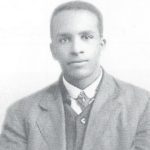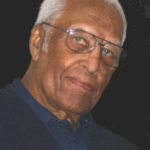A History of Educators in the Alexander Family – Part 1
Nelson Mandela once said, “Education is the most powerful weapon which you can use to change the world.” This message is represented in the Alexander family, considering their long and significant history of educators in not only Amherstburg, but throughout Essex County and Chatham-Kent. It all stems back to John H. Alexander who was the principal of the King Street School located down the street from the Amherstburg Freedom Museum. John H. Alexander was the son of Thomas and Catherine (Harding) Alexander. Thomas was born in Germantown, Kentucky in 1815 and Catherine was born in Buckingham, England. Thomas came to Canada in 1848, where he was “a highly respected resident of Anderdon.” At the age of nine, Catherine moved from England to Buffalo, New York – an ocean voyage that took six weeks. She later moved to Ohio where she met Thomas. The couple was married on 5 June 1848 and soon after moved to Anderdon, where they had three children: John H., Philip Harding and Martha. Described as “pioneers of Anderdon,” the couple was together for 42 years.
Thomas and Catherine’s daughter, Martha married the Reverend Oscar A. Johnson of Amherstburg, who was the son of Weden Johnson. Martha married a second time, which was to M.E. Simms of Providence, Rhode Island. Thomas and Catherine’s son, Philip, married Emma Jane Lott of Anderdon, but sadly she only lived about a year after their marriage and they had no children. Philip worked in construction and also at the local quarry, but he was best known as one of Amherstburg’s prominent marine chefs. Following his time at the quarry, Philip began his work as a marine chef, even running the kitchen on different boats of the Northern Navigation Company.
Of Thomas and Catherine’s children, John H. Alexander, the teacher and principal of the King Street School in Amherstburg, is the most well-known. He was born on October 15, 1857 in Anderdon, where he also attended public school. From there he entered the Windsor High School and later went to London Normal School, where he received a teaching certificate. He taught from 1878 to 1917 at several schools beginning with Puce and North Buxton in 1878. The following year, in 1879, he taught in Dresden and then the King Street School in Amherstburg. That same year he accepted the position of principal and remained at the King Street School for 30 years. When he first started teaching at the King Street School he had an enrollment of 62 pupils and it was said in the Amherstburg Echo that “Because of his ability, his knowledge of youth and his kindly understanding of their difficulties both in and out of school hours he was loved by all his pupils and he set them a sterling example that helped many to win success in both American and Canadian cities.” Included among his students was Thomas Thompson, who was the very first person of African descent to own the Taylor Cabin, located at the Amherstburg Freedom Museum. In 1909, John began teaching in Tilbury and a few years later, in 1912, went back to the place of his birth to teach in Anderdon, a position he held until his retirement from teaching in 1917.
From the information written about John Alexander, he was highly active in his community and a very well-respected man. In 1923, he was elected as an Amherstburg Town Councillor and served from 1923-1926. A few years later, in 1930, he was also appointed Town Assessor, which he did until his death on August 31, 1934. This is in addition to acting as town auditor and Superintendent of the A.M.E. Sunday School for 20 years. John was also known as an excellent public speaker who was in demand at many public gatherings which included Emancipation Celebrations. At a 1928 Emancipation Celebration, John “stressed the hospitality of the town [Amherstburg] and the unique and fitting feature that it was here Eliza and George Harris made famous by Harriet Beecher Stowe found refuge in the early days.” Stay tuned for next week’s installment.
A History of Educators in the Alexander Family – Part 2
Among the personal details of his life, John Alexander married Annie Louise Crawford on July 27, 1883 and the couple owned a large house and part of lot 12 on Alma street. John purchased the house and property from a Dr. Hobley in 1889. Annie was the daughter of George M. and Laura (Virginia) Crawford who settled in Amherstburg in roughly 1845. Annie’s father George was described in the Amherstburg Echo as “of Cherokee Indian descent and came north from the Southern States when a young man. He was a master carpenter and many of the houses he built in Amherstburg of timbers and lumber that had to be hewn and dressed in the bush are still standing as proof of their sturdy construction. The First Baptist Church is one of them.” Annie’s mother Laura was born into slavery in Covington, Kentucky and escaped enslavement at the age of 15, reaching freedom in Amherstburg. Soon after she met and married George.
Several years after their arrival in Amherstburg, the couple welcomed Annie into the world on February 15, 1861. Annie was born in Amherstburg, where she lived all her life until her passing on August 10, 1935. Annie attended the King Street school in Amherstburg, of which John Alexander later became the principal and taught there for over 30 years. Annie was also a life-long member of the First Baptist Church that had been built by her father. She was described as a woman devoted to her home and family, her church and community. John and Annie had six children: Dr. John Harold Alexander; Miss Nina Mae Alexander (Welland, Ont.); Arthur H. Alexander (North Buxton, Ont); Miss Ethel L. Alexander (Belize, British Honduras); Anna, Mrs. Charles A. Webb (Detroit, Mich.), and Marjorie, Mrs. J.A. Foster (Amherstburg).”
Three of John and Annie’s children, Mae, Ethel Landonia and Arthur Alexander, chose to follow in their father’s footsteps by also becoming teachers. In August 1914, Mae and Ethel replied to an advertisement posted by the Six Nations School Board and were hired. Mae and Ethel both taught at the No. 2 School, while their brother Arthur taught at No. 7. Mae, Ethel, Arthur and Arthur’s wife (Ethel) lived together in the teacher’s residence in Ohsweken. While teaching for the Six Nations School Board the three Alexanders experienced discrimination firsthand after the President of the Indian Moral Association, Mrs. George D. Styres, requested their dismissal based solely on the colour of their skin. Styres believed that they would not set a good example for the students, despite the fact that they received very favourable reports on their teaching. Ethel also held a third-class teaching certificate and had five years of teaching experience, while Mae had a second-class certificate. The Alexanders were respected teachers who each had multiple teaching opportunities, but racist beliefs unfairly called into question their abilities. Deputy Superintendent, General Duncan Campbell Scott, consulted “Indian” Agent Gordon Smith who defended the Alexanders saying that there were no complaints from parents and “they were “highly respectable and well thought of.” He also warned that if they were fired, the local newspaper would raise attention to this racist act and that it was “un-British” to dismiss them based on their skin colour. Mrs. Styres was then told that the Alexanders would not be dismissed from their teaching positions but soon after, Arthur left his position in 1920 for a better paying job in Buxton. Following his departure, Gordon Smith stated that Arthur “has given better satisfaction at No. 7 School than any other teacher who has been there before, and the Trustees admitted that. It is a great misfortune to the Reserve to lose this teacher.” A few years later, there was another protest which may have led to Ethel and Mae’s departure. After they left Ohsweken, Mae returned to Amherstburg to teach there. Ethel worked for many years as a missionary teacher in Belize (British Honduras) beginning in the summer of 1922 and she remained there until 1950. While on a trip to Belize, a former Amherstburg resident, Harold Pillon, recalled that Ethel worked as a missionary there and asked one of the residents if he remembered Ethel. As the man’s face lit up, he said “I remember her with affection.” There’s still more to come next week. Stay tuned.
A History of Educators in the Alexander Family – Part 3
Before becoming a teacher, Arthur, who was born in Amherstburg on November 2, 1884, worked in several occupations before he became a highly respected teacher and principal. He worked as “the Printer’s Devil” for the Amherstburg Echo, which involved an apprentice or errand boy working in a printing office doing tasks such as sweeping and cleaning the ink off the ink rollers. Arthur also worked as a cook on the “Alexander Leslie,” a freighter that sailed the Great Lakes. He used the money he earned on the freighter to further his education.
From there Arthur became a teacher, later a school principal. He taught in the North Buxton area for 40 years at S.S. No. 13 and his dedication to education earned him the Fred L. Bartlett Memorial Award which was given by the Ontario Public School Teachers Association to honour teachers who made a valuable contribution to education in the province. He received the award at the age of 89 and Arthur was the first Black educator to be nominated for the award. It was said that “Mr. Alexander’s outstanding leadership was known far beyond the area” and he “lifted the educational standards of an entire community.” He taught in a one-room school house, later a two- room school house at the Buxton school and was recognized as one of the best educators in the area. This was despite dealing with the racial climate of the time. It has been said that other educators felt that “he would have advanced higher in Ontario education but was limited because he was a black teacher in an era when opportunities were limited to a few segregated schools.” To be recognized for his work through the Bartlett Award despite these obstacles shows his true dedication to education. Arthur never had less than 50 pupils in his class which included eight grades and he loved music. He even used a mandolin as a teaching aid to instruct students on how to sing. According to Arthur, “The mandolin looked like a potato bug … So that’s what I called it. The students usually got a kick out of that.” Arthur’s grandson Philip also recalled his father (Philip V.) saying that the school inspectors always made a point of going to the North Buxton School at a time when they would be able to enjoy the performance of “Pirates of Penzance” or other Gilbert and Sullivan productions by Arthur’s students. Arthur retired in 1954 and positively influenced countless student’s lives while teaching.
Arthur was also active in the community considering he was a church deacon for more than 50 years, Superintendent of the Sunday School and chairman of the local Temperance League. He also assisted in the establishment of the Buxton National Historic Site and Museum and was a founding member of the National Unity Association which was responsible for the passage of the Fair Accommodation Practices Act in 1954, which stated that no business could refuse a person based on their “race.” Arthur had the personal philosophy that the world should be viewed with humour and enthusiasm, which is something he incorporated into his career as a teacher, his work in the community, but also his marriage to Ethel May Alexander who was born in North Buxton. She was the daughter of Charles Shreve and Elizabeth Dyke and they had four children: Gloria Roby (Detroit), Philip (Windsor), John Arthur (Chatham-Kent) and Ronald (California). Don’t worry. There is still another part left of the Alexander history. See you next week!
A History of Educators in the Alexander Family – Part 4
Arthur’s children must have recognized his love of teaching, considering some of them also became teachers. Ronald, a Professor Emeritus of Communication at Stanford University, taught documentary filmmaking for 18 years in the graduate program of the Department of Communication. In 1970, he was invited to Stanford as a visiting lecturer for six months and was soon after offered a permanent position. This is all despite not having a bachelor’s degree. Ronald retired in 1988 but was a beloved mentor to countless students. Ronald’s career in film began while he worked as a sleeping car porter of the Canadian Pacific Railway. It was while working that he met the wife of the commissioner of the National Film Board of Canada and she was so impressed by him that she introduced Ronald to her husband who then recommended Ronald for a job in the technical research department. He also worked as a re-recording sound mixer at the National Film Board of Canada and his name is listed in the credits of almost 300 films. Ronald also developed and patented a soundtrack-mixing device known as CUE VUE, which is a system still in use today.
The educators of the Alexander family did not always teach in the traditional classroom setting as is the case with Gloria who became a music teacher and taught many North Buxton residents to play piano. Gloria’s brother Philip Valoure, who was a carpenter and cabinet-maker, went on to marry the daughter of the Reverend H. Talbot (Windsor), Elsie Adele Talbot on October 2, 1940. Philip was a long time Sunday School Superintendent at the First Baptist Church in Windsor. Although Philip was not a certified teacher, he did teach Sunday School classes which has an educational component. Sunday Schools were a place where children received both a religious and academic education. During the nineteenth century, in some areas the only education that children received was in Sunday School, once a week. People such Mary and Henry Bibb were among the leaders who taught reading and writing in Sunday School in addition to teaching Bible classes. Through the years, organizations such as the Amherstburg Regular Missionary Baptist Association continued the tradition of educating youth by having them compose and read essays or read minutes and reports. Even though his lessons were not in a traditional classroom, Philip enriched the lives of his students.
Philip and Elsie had two sons: Philip Henry (Windsor) and David Valoure (Belleville) and they also taught in one way or another. David taught outdoor painting at Seneca College in 1970, in addition to teaching Art at Albert College in Belleville from 1979 to 1992, and from 1992 to 2011, he taught for the Hastings Prince Edward District School Board. David’s brother, Philip, who has a significant connection to the museum as one of its founding members, has an impressive academic career that complements his family’s pursuit of knowledge. Phil received a Bachelor of Applied Science degree from Assumption University in 1963 and a Master of Applied Science degree the following year, 1964, from the University of Windsor. Each degree was in Electrical Engineering. Phil pursued further graduate work at the University of Michigan, Ann Arbor (1970-1972), but his devotion to academia did not end with his graduate studies, as he began working as a professor at the University of Windsor in 1964. Not only did he work as Associate Dean (Academic) for the Faculty of Engineering, he continued teaching as an Associate Professor in the Department of Electrical and Computer Engineering at the University of Windsor until his retirement.
The tradition of educators in the Alexander family continues in ongoing generations including Philip’s children. Dan Alexander and his wife Paula are both elementary school music teachers, while Phil’s daughter Paula (McGlaun) teaches Law and Physical Education courses, in addition to coaching, at Walkerville Collegiate Institute. Clearly, members of the Alexander family recognize and appreciate the importance of education. Whether through academics, music or art, education is woven throughout their family’s history and continues with each generation. Thank you for joining us for the Alexander Family history. Join us next week where we will introduce another amazing family.









